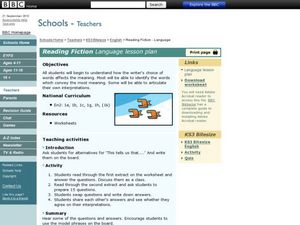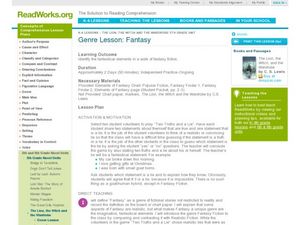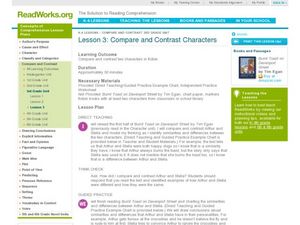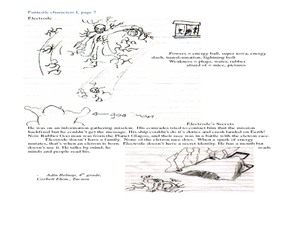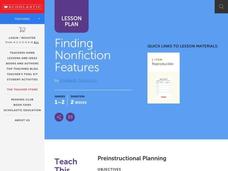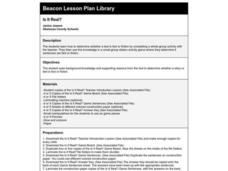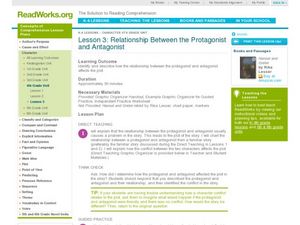Curated OER
Reading Fiction
Explore how a writer's choice of words can convey meaning to the reader. Learners read selections and write questions about the content. Each question is answered by two groups of students and the differences in interpretations are...
Curated OER
Welcome To Your Library
As an overview of the positive things the library has to offer, this would be a helpful presentation. However, it does not provide much information. This presentation could be augmented by adding details about the Dewey Decimal system or...
Curated OER
Genre Lesson: Fantasy
Young scholars study the elements of fantasy in fiction as a whole group by dissecting fiction stories. In this story elements instructional activity, students work through a handout about fantasy to point out the elements that point...
Curated OER
Compare and Contrast Characters
Third graders compare and contrast. In this compare and contrast instructional activity students find similarities and differences between two characters from a fiction book. Students use a graphic organizer.
Curated OER
Comparing and Contrasting Fiction and Nonfiction
Second graders analyze differences between fiction and nonfiction texts. In this compare and contrast lesson, 2nd graders review texts, discuss similarities and differences, and complete a Venn Diagram.
Curated OER
Distinguishing Fiction and Non Fiction
Have your class go on picture walks of different books, and identify them as either fiction or non fiction and why. Working in groups, kindergartners state whether the book tells information or comes from the author's imagination. Use...
Curated OER
Causes
Things usually don't happen without a reason; usually any event has a cause that got the ball rolling. The book, If You Give a Mouse a Muffin is used to help learners understand the concept of causes in literature. Examples from the...
Curated OER
Lesson 3: Cause and Effect Relationships
The Gunniwolf is a book full of events that get kids asking why and what. They note several events on a chart, and then discuss how they think the instructor is able to determine the causes and effects they find. They continue reading...
Curated OER
Identifying Setting and Completing a Story Map
Second graders complete a story map for Frog and Toad Are Friends. In this making inferences lesson students find specific details from the book to complete their story map. They map one chapter at a time.
Curated OER
fantastic Characters
Students study stories. In this writing lesson plan, students discuss the three aspects of a story, read stories focusing on the characters, write a story as a class about a character made up by the class, and write a story with an...
Curated OER
Satire in Fiction
Twelfth graders identify satire in various fictional texts. For this language arts lesson, 12th graders will learn to define satire, parody, and caricature. Students will identify different forms of satire in historical and modern-day...
Curated OER
The Power of Fiction
Students explore fiction that moves individuals to social action. In this literature lesson, students read The Jungle by Upton Sinclair and analyze its literary worth as well as its investigative journalism. Students investigate other...
Curated OER
Finding Nonfiction Features
Young scholars review the differences between a fiction and non-fiction book. In groups, they use different non-fiction books to identify the eleven features that distinguish it from a fiction book. To end the lesson, they create a...
Curated OER
TELL THE SEQUENCE IN AN ORAL REPORT
Second graders survey a favorite story he/she has read or heard read aloud. They use the graphic organizer to draw illustrations that show the beginning, middle and end of the story. They tell the title of the story, whether it is...
Curated OER
We Like to Imagine - Animals
Students describe a pretend animal. They read "The After School Monster." Students read other books and discuss whether or not the characters are real. Students make a drawing of a pretend animal and of a real animal. They make up a...
Curated OER
Friendship
Learners investigate the concept of friendship as part of a four lessons unit which integrates literature with language arts, family life, social studies, or religious studies. Peace, cooperation, social justice, and multicultural...
Curated OER
Is It Real?
First graders see how to determine whether a text is fact or fiction by completing a whole-group activity with the teacher. They use this knowledge in a small-group station activity game where they determine if sentences are fact or...
Curated OER
Is It Moose-Mooses or Moose-Meese?
Learners play librarian and have to shelve books on moose after determining whether the books are fiction or non-fiction. They must study Alaska and follow a format of questions to determine where to shelve the books.
Curated OER
Context Clues, Plot Structure, Conflict, and Personal Narrative Essay
What are the elements of a personal narrative? Get your class talking by reading "The Necklace" and "A Dangerous Game." The lesson focuses primarily on defining certain vocabulary terms (like context clues, plot, conflict, climax, etc.)...
Curated OER
Hattie and the Fox
Who is Hattie? Youngsters explore animal characteristics by reading poems and stories in class. They read the book Hattie and the Fox about a fictitious fox and his drama with the other farm animals. Then they reread the story over...
Curated OER
Lesson Plan 1: Introducing NaNo and Novels
Did you know that November is Novel Writing Month? In the first of a series of lessons, class members are introduced to the NaNoWriMo (National Novel Writing Month) project.
Curated OER
Predator Book Quiz
In this fiction books worksheet, students complete 7 multiple choice questions about the book, "Predator." These questions contain concepts such as choosing the correct author, who published the book, when it was on the New York Times...
Curated OER
Relationship Between the Protagonist and Antagonist
Students read Hansel and Gretel, and discuss the conflict in the story, while determining who the protagonist and the antagonist are. In this fiction lesson, students chart the conflict in the story they have just read.
Curated OER
Explicit Information in Fiction
Second graders analyze the use of explicit information in fictional texts. In this language arts lesson, 2nd graders read a story and use the text to answer questions.


